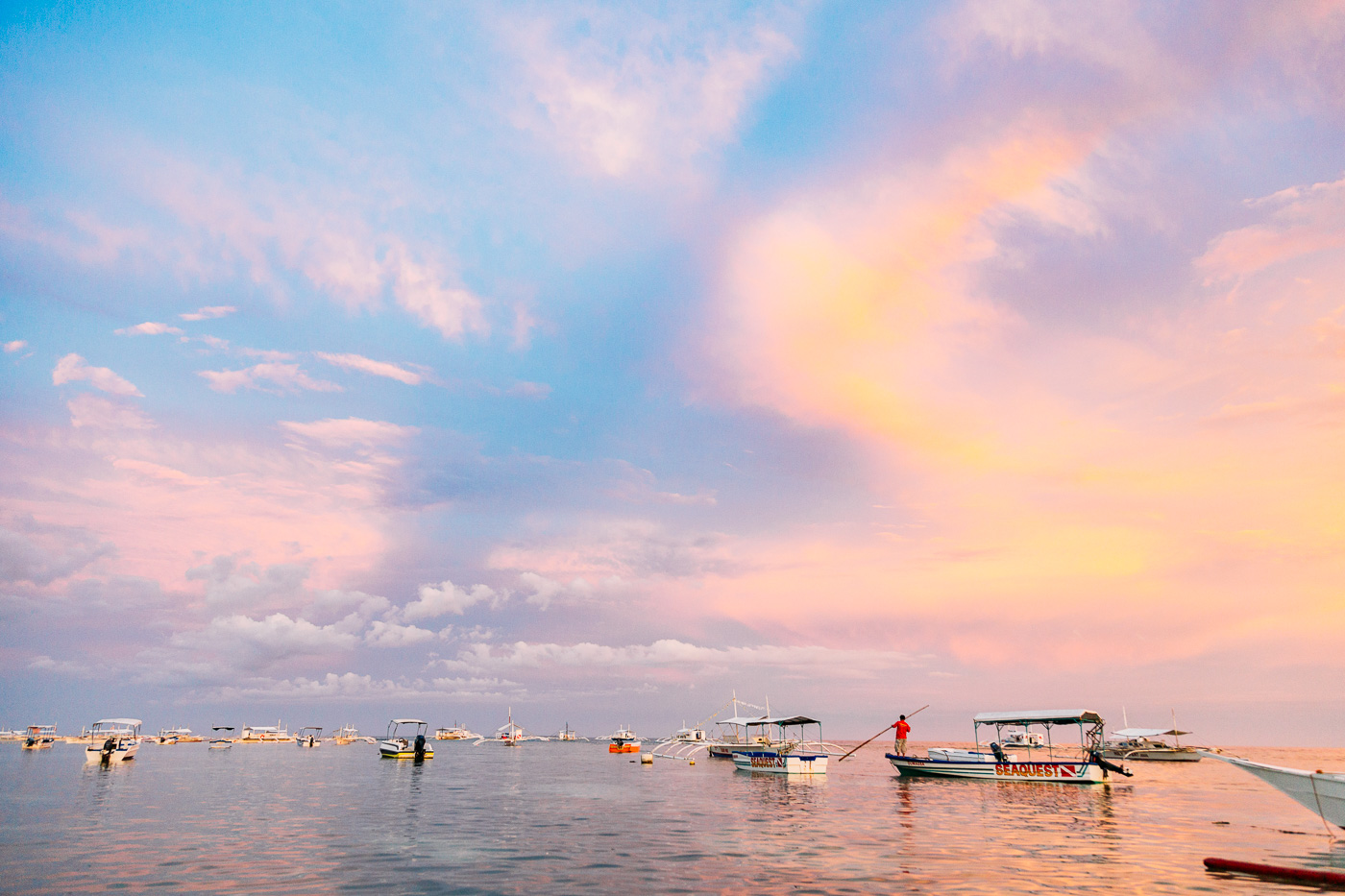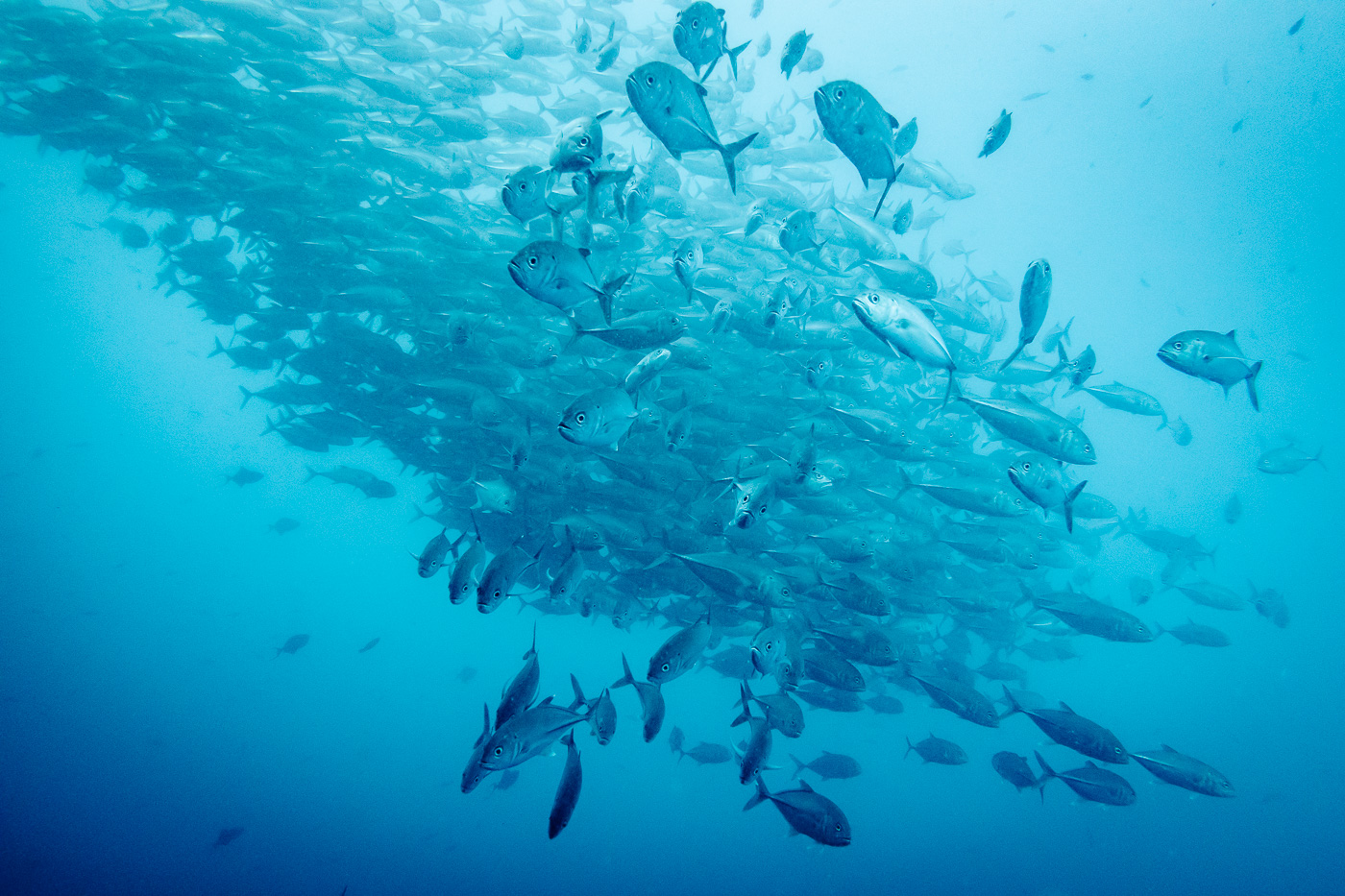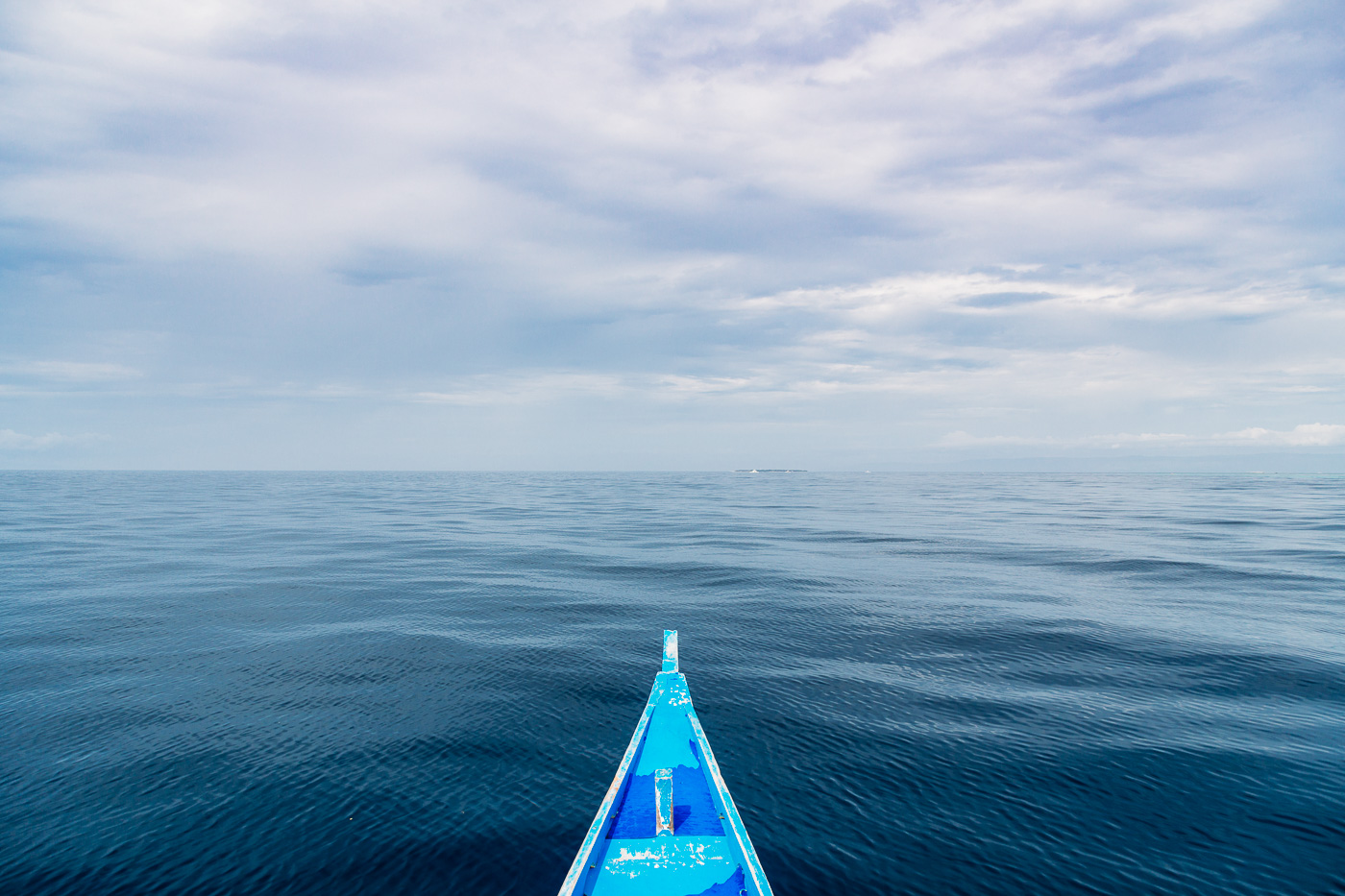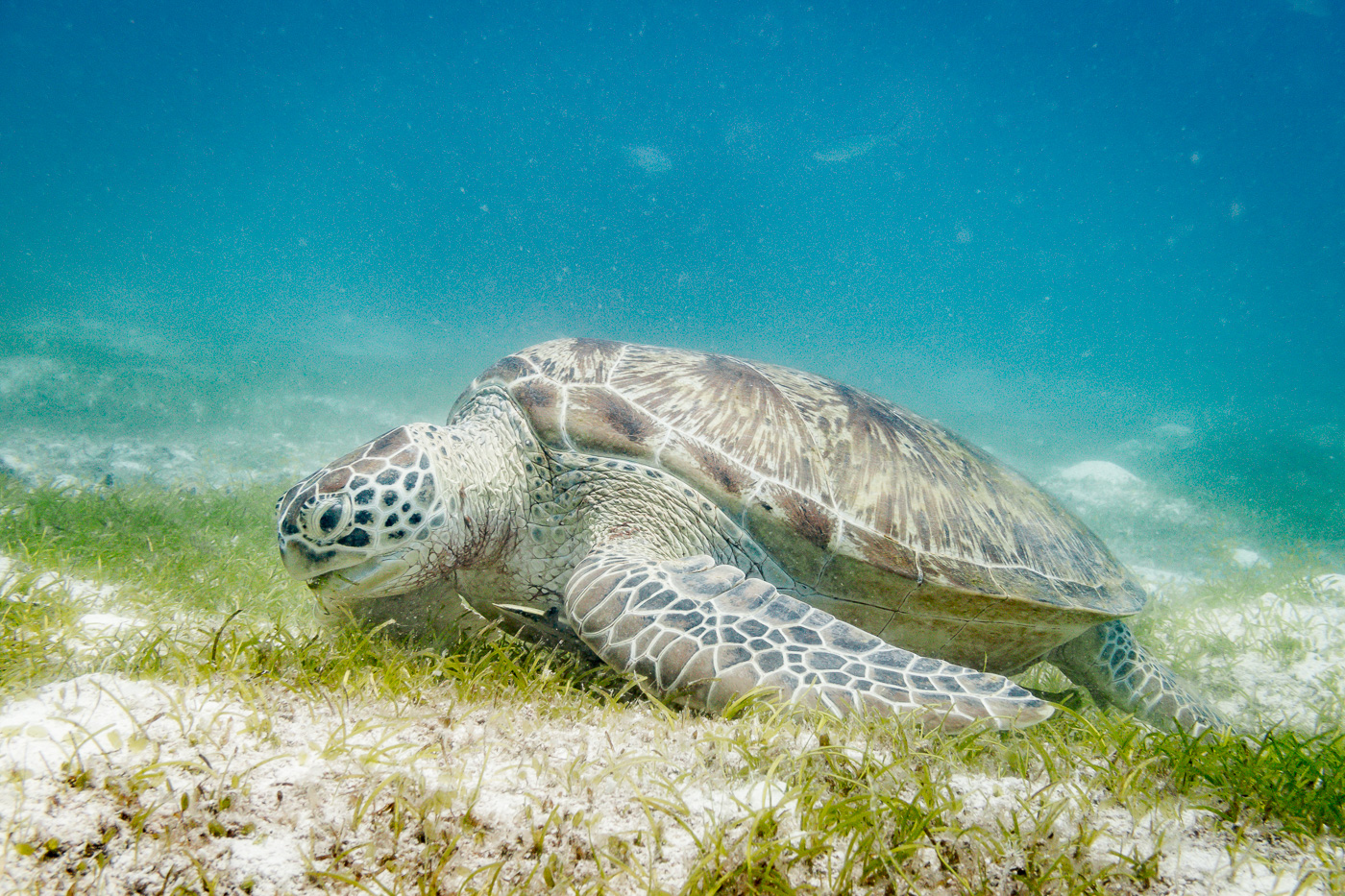We felt a bit of disappointment when we made the decision not to visit Oslob on our quest to swim with whale sharks. After all, this was the adventure that put the Philippines on our bucket list. That was until we did a little more research and spoke with some locals about the damaging practices that tourism and feeding the whale sharks in Oslob have had on their very existence. But more on that to come. Luckily we weren’t disappointed for long as our next stop was Alona Beach on Panglao Island, Bohol. Here we signed up for Sierra Madre Divers’ AWARE Sea Turtle Specialty Identification course. Our day trip to Balicasag Island let us get (reasonably) up close and personal with green and hawksbill sea turtles and a school of jack fish that call this nature reserve their home. And we were able to contribute to crucial ongoing work to preserve the sea turtle species in the Philippines. Here’s why our day of AWARE sea turtle specialty identification at Balicasag Island turned out to be a more authentic and conscientious marine encounter than swimming with the whale sharks of Oslob would have been.
 The Reality of Oslob’s Whale Shark Zoo
The Reality of Oslob’s Whale Shark Zoo
There are few places in the world where you are guaranteed the opportunity to swim with whale sharks. It turns out there’s a reason. Whale sharks are a highly-migratory species who swim great distances in search of nutrient-rich plankton. By staying in Oslob as they’ve been baited by the local fishermen, their breeding patterns are being impacted causing serious concern for their long-term survival.
Another unintended consequence of Oslob’s whale shark draw is that uneducated tourists and local fishermen don’t follow whale shark interaction code of conduct and touch these great gentle giants.
We should mention that we didn’t even stop through Oslob. (From what we hear there is no reason to unless you are planning an early morning tour to see the whale sharks.) So we can’t actually speak firsthand about how the whale sharks are being treated. However, we’d see enough videos from other tourists to know this whale shark zoo wasn’t something we wanted to participate in. Our suggestion, if you are considering Oslob as part of your Philippines itinerary, is to check out this post first to get a sense for what you, and the whale sharks, are in for.
So while this trip to the Philippines ultimately didn’t deliver the great whale shark swim we were so excited about, we know when we eventually do get to see one in the deep blue it will be a happy chance encounter as s/he swims freely by. And as a beautiful consolation, we were able to spend a peaceful day identifying turtles with Sierra Madre Divers for LAMAVE and observing jackfish schools at the stunning nature reserve at Balicasag island.
AWARE Sea Turtle Specialty Identification Course at Balicasag Island
On this day we were at Balicasag Island for the primary purpose of completing the Sea Turtle AWARE Distinctive Specialty as part of our PADI Advanced Open Water course on Bohol. Sea turtles are a keystone of the underwater ecosystem – they help to maintain productive coral reefs by transporting essential nutrients from the ocean to beaches and dunes. For this reason you can tell a lot about the state of our ocean environments by studying sea turtle health. Unfortunately today major shifts in climate change, overfishing and ocean pollution are threatening the very existence of sea turtles. And this is really bad news for everyone because as the sea turtle populations decline, so too does their ability to fulfill their vital function in the ocean ecosystem.
When we signed up for our PADI Advanced Open Water, we were psyched that our Panglao dive center offered the AWARE Sea Turtle Specialty course. It gave us the chance to learn all about sea turtles, including how to identify the different species, as well as causes of concern for their long-term survival and what we could do about it. But the coolest part was the opportunity to participate in the Large Marine Vertebrates Project (LAMAVE) efforts to identify mature females for tagging while diving at Balicasag Island by spotting and taking photos of those living in the area.
Goals of the AWARE Sea Turtle Specialty Course
Our AWARE Sea Turtle Specialty Distinction course started in the classroom where we learned:
- Sea turtle species common in tropical waters, including the five species currently found in the Philippines
- The knowledge and skills needed to identify turtles and record sightings while at Balicasag
- About the decline of sea turtle populations and the importance of sea turtles to marine biodiversity
- The threats that the marine sea turtle population faces and how we can personally help with conservation
How to Identify Sea Turtles
Sea turtles are identifiable by species and sex if you know a few key characteristics. At Balicasag Island, we were likely to see two species of sea turtle in particular – the green turtle and the hawksbill turtle. The green turtle is named for the color of its body fat, which has a green hue. They are the second largest species after the leatherback and feed on grass. The Hawksbill turtle, on the other hand, feeds on sponges and soft corals. It’s distinguishing feature is its narrow head and pointed beak.
Telling the difference between a male and a female is more difficult but could be determined by examining the tail and front flippers. Sexually immature males and females have shorter stubby tails while sexually mature males have much longer tails to house their sexual organs. Males also have long and curved claws.
Rules of Engagement with Sea Turtles
Of course the last thing we wanted to do was disrupt the way of life of the Balicasag sea turtles, as tourists had done for the Oslob whale sharks. So it was important for us to learn the rules of engagement while observing the sea turtles in the water.
As with any animal in the wild, sea turtles must be approached thoughtfully and with caution. First, sea turtles should not be approached closer than 2 meters and approaches should be made from the frontal view so as not to alarm. The maximum amount of time you should spend with a turtle is 30 minutes and absolutely no touching or handling is allowed. Finally no more than 4 people should be around a sea turtle at any one time.
Threats to Turtles & How You Can Help
Worldwide, six of the seven sea turtle species are classified as threatened or endangered. And sadly the biggest threats are a result of human actions and lifestyles including: entanglement in fishing gear, poaching and illegal trade, coastal development, plastic and other marine debris, global warming and ocean pollution. During our course, for example, we learned that 300,000 turtles die each year indiscriminately by being caught on long fishing lines.
If you are interested in learning more about turtle and ocean conservation efforts in your area, the following organizations are a great place to start:
Learn more about Project AWARE.
Learn more about Marine Wildlife Watch of the Philippines.
Learn more about Sea Shepard.
 Reasons to Dive Balicasag Island
Reasons to Dive Balicasag Island
As if sea turtle conservation wasn’t enough reason to dive Balicasag island, this marine sanctuary is a pristine underwater paradise. We dove two dive sites at Balicasag – Black Forest and Balicasag Marine Sanctuary.
Balicasag Marine Sanctuary Dive Site
The Balicasag Marine Sanctuary is a deep wall dive extending as far as 200 meters in some spots. Large soft and hard corals protruding from the wall were a regular feature of on dive. At one point we were surrounded by a school of fluorescent purple fish, which glowed in contrast to the wall behind them while a massive napoleon wrasse swam away. But the most exciting moment was encountering a small school of jackfish almost immediately after dropping in down. Unfortunately we were already so deep at this point we didn’t get to visit with them long before they swam away. We were disappointed not to see any turtles at Balicasag Marine Sanctuary for our sea turtle course but were also completing our Nitrox certification so were likely too deep for regular spottings.
Black Forest Dive Site
Black Forest is one of the most popular sites at Balicasag Island as a steep slope dive extending to about 40 meters. It is named black forest because of the unusual black soft corals which are typically found at deeper depths but here thrive around 15 meters. The reef was beautiful and full of color and life. Happy clown fish can be seen everywhere curiously exploring from their anemone homes. And our dive master, Bernard, was a pro at spotting different species of nudibranch.
It was also here at Black Forest that we were able to complete our AWARE sea turtle specialty identification, spotting 2 hawksbill and 3 green turtles.
 How to Get to Balicasag Island
How to Get to Balicasag Island
Balicasag Island is located in the southern Bohol sea a 45-minute boat ride from Panglao Island. It can be reached from Alona Beach via Tagbilaran City. Most Bohol dive shops based on Alona Beach, Panglao Island offer regular trips to Balicasag Island. We included our day trip to Balicasag as part of our Advanced Open Water course with Sierra Madre Divers.
Fast boats from Cebu City and Dumaguete City leave daily and take roughly 2 hours to get to Tagbilaran City. Tickets can be purchased at the pier but arrive early. We took Ocean Jet and Super Cat and were happy with both companies. From Tagbilaran City, you can hire a moto, trike or taxi to take you Alona Beach on Panglao Island. The drive should take no more than 1 hour.
If coming from Manila, regular flights depart for Tagbilaran City daily. From here hire a taxi or trike to get to Alona Beach on Panglao Island.
 If You Go: AWARE Sea Turtle Specialty Identification Diving at Balicasag Island
If You Go: AWARE Sea Turtle Specialty Identification Diving at Balicasag Island
What: Diving with whale sharks in Oslob, Cebu sounds like a dream come true until you learn how harmful this practice is for these gentle giants’ way of life. If you are looking for a more authentic and impactful diving experience in the Visayas, Philippines, look no further than the Sea Turtle AWARE Specialty Identification course with Sierra Madre Divers on Alona Beach, Bohol. Here you will learn all about sea turtles and their role in the ocean ecosystem and have the opportunity to contribute to LAMAVE’s ongoing sea turtle identification and tagging program at Balicasag Island to support Philippines turtle conservation efforts.
Where: Balicasag Island is small island located in the southern Bohol sea a 25-minute boat ride from Panglao Island in the Visayas, Philippines.
When: Bohol scuba diving is best between October and May.
How: Sign up for Sierra Madre Divers’ Sea Turtle AWARE Specialty Identification course or take your diving to the next level with their PADI Open Water and Advanced Open Water certifications. Balicasag Island is typically visited as a two-dive day trip from Alona Beach on Bohol.
Disclaimer: Our AWARE Sea Turtle Specialty Identification was supported by Sierra Madre Divers. As with everything on our blog, our opinions above are an honest account of what we experienced. As you consider your options for Bohol scuba diving reach out to Jaki at Sierra Madre Divers (+63-385029789, info@dive-bohol.com).






















